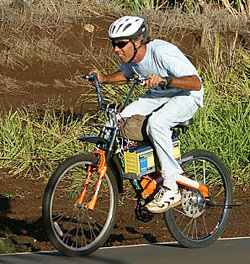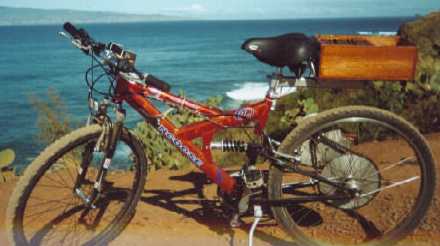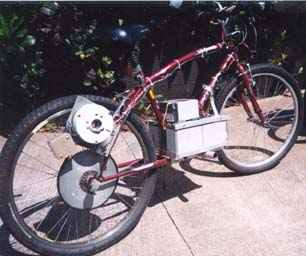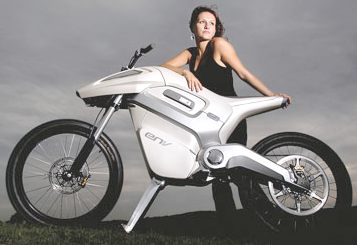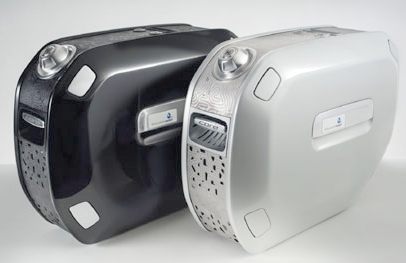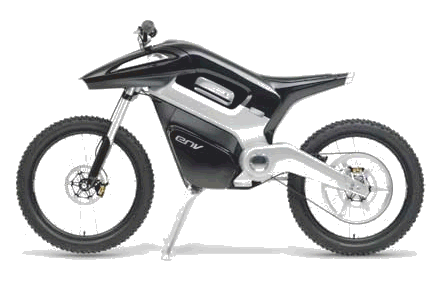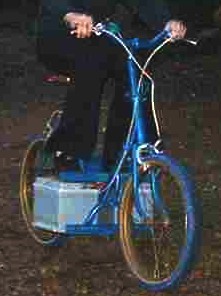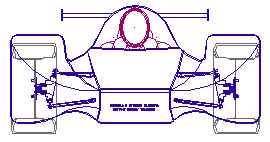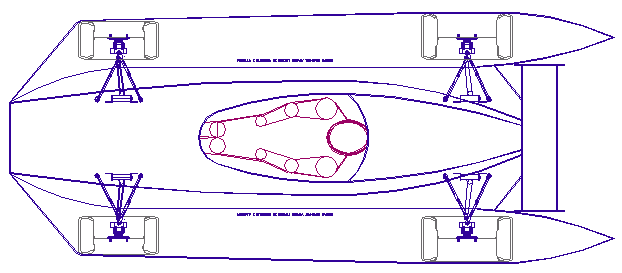|
ELECTRIC CYCLING HISTORY & LINKS
|
|
||||||||
|
HOME | AUTOMOTIVE | BLUEPLANET | ELECTRIC CARS | FORMULA E | ENERGY | INSURANCE | INDEX | SOLAR CARS |
|||||||||
|
http://Ev-Motors.com EV Cycling-to-the-Sun http://cycletothesun.net
In the toughest 36 mile hill climb in the world, this custom electric bike showed it had what it takes to set a new record.
Randy Draper on his electrically assisted mountain bike climbing Haleakala volcano, Maui.
The road is billed as the world's steepest. It climbs nonstop from sea level to the peak of the 10,005 feet high volcano Haleakala on Maui, over a distance of 37 miles. The race up it, called Cycle to the Sun, was conceived of as the world's toughest bicycle hillclimb. But in this year's race, held on August 17th, a rider on an electric power assisted bicycle, using advanced batteries and a motor he made himself, has completed this endurance feat for the first time, near the head of the pack.
Randy Draper, the constructor and pilot of the modified bike, was drawn to the race not as a competition against human power, but rather as an extreme test of his unique design approach to light EV's. Using an unusually efficient 750 watt brushless motor he designed himself, a modified three-speed hub shifter from bicycle component maker SRAM, and a 48-volt nickel-zinc Evercel battery pack, his full-suspension mountain bike is a test bed where total over-the-road efficiency is the guiding rule.
While most familiar commercial electric bikes use a 250 to 400 watt motor and lead acid batteries, Draper wanted more power for hill climbs, better efficiency at a wider range of speeds, and much greater range. His 7 lb. motor design has been used in prototype boats, bikes, and also is just as efficient as a generator. Draper uses one in a windmill to add power to his solar array at his home in Lahaina, also on Maui. At one point he even made a 10 mile island crossing in a small solar powered catamaran powered by the motor.
The race would have been impossible to complete on any commercial stock e-bike. Not only is the road too steep, averaging 5% in grade but with long stretches over 15%, it is also far too long. Most e-bikes would have trouble completing a fourth of it before the batteries died. Even with better batteries the motors are not designed for long efficient runs at 750 watts and would overheat. But Draper figured with his efficient setup and a new type of EV battery with nearly twice the power of lead acids, the distance might just be within reach.
With assistance from Bob Ketell at Electricab Energy in California, the U.S. distributor of Evercels, Randy got four of these batteries and grafted them onto his specially prepared motorized mountain bike. The race promoters were intrigued and enthusiastic about the prospect of an electric bike competing alongside the cyclists, though he was asked to start after all the human-powered entrants.
At the 6500 foot elevation point, the road enters the National Park, the crown jewel of which is the enormous volcanic crater towering over a commanding view of the sea and the islands. An alternative end point of the race is just inside the Park for those not wanting to test their lungs and legs at the higher altitudes. "One park ranger yelled at me to stop at the park toll at the National Park entrance. As I sped by at 25 mph I yelled I was in the race."
Upgraded
350w electric cycle
RANDY writes: I started at the back of over 250 pro riders from around the world. Starting from the beach I managed to get out in front by the 2500 ft marker. From then on I maintained the lead by close to 4 miles ahead of everyone until 1/4 mile from the 10,005 ft summit. The Evercels stayed in the mid 50 volt range until the last 3 miles. At half way the ratio of amps per mile was 16 amps at 20 miles. As the steeper part came up I noticed I was getting a little less than 1 amp per mile .The voltage was still about 53 volts and I started loosing about 1 volt per mile with 10 miles to go. As the observatory was up on top of a giant hill it was so close and so far away at a 1/4 mile. With only 36volts at that point I started walking for about 20 yards using just enough power to pull my 125 lb bike along.
After resting for 15 minutes with 1/4 mile to go the 3 in the Mavic team passed me by to win I think 3 in all, I did get a picture of them passing. Just for the hell of it I jumped on my bike and it took off to my surprise and finished in 3 hours and 3 minutes 58 sec, using 37.334 amp/hours in 37.35 miles. I was working on my new bike all night to get it ready and never had time to test it or cycle the Evercel batteries. At the summit about a half hour after I finished I noticed the voltage at 53volts so I rode it around at the top for another half hour... Hmm ... those Evercel batteries are amazing! :-).. Right now I'm missing the awards Ceremony but I haven't slept in 48 hours.. Was a beautiful day and caught the eye of everyone I passed in the race and along the road. It is documented by http://Cycletothesun.net It is a worlds EV record for climbing steepest road in the in the world.. as far as I know.12.2 mph was my average time, mostly in 1st gear.
I think it's a world record.. I now have a 100+range bike at 20-30 mph 1600 watt peak but rarely use over 750 watts. Got to 10,005 feet from sea level in 3 hours 3 min and 58 sec.
Randy is looking for a lithium battery manufacturer or bike company to produce an electric cycle incorporating his 3 speed system, or to sponsor his next record breaking project: the volcano in 2 hours!! If you are interested why not email him: Randy Draper
MONGOOSE: ELECTRIC FULL SUSPENSION MOUNTAIN BIKE
Mongoose - electric cycle
(Sram Dual Drive 3 speed hub) in common with the motor, pedals and derailer gears, on a separate freewheel will go (up to 33mph top speed) for 26 miles with no pedaling. You could go for 35 miles plus, with some pedaling on 14 amp hour (agm) batteries on any terrain round trip. The motor or pedal gearing is fully adjustable for speeds up to 35mph.The motor and controller will operate to 1000 watts at 36 volts (2000 rpm free spinning) or 1250 watts at 48 volts (2600 rpm free spinning). A single motor reduction of 8 to 1 on a 26" wheel (at 48 volts) will take you (22 mph top speed) on a 100 lb. bike with a 160 lb. rider, at a average round trip speed of 17,5 mph for 26 miles with no pedaling. At a average trip speed of 17.5 mph you can get 1 mile per 18.5 watt hour.1 amp hour will get you 2.6 miles at 48 volts. With using a higher gear you could average 24.5 mph using 24 watt hour per mile. Nimh batteries would give you a better range and speed.
HUFFY: A STYLISH RIGID FRAME BIKE
Huffy - electric cycle
The same motor, the Sram 3 speed hub, and no pedals. This 105 lb. bike set up will go up to 37 mph. At a average speed of 20+mph the bike will go for 20 miles on 480 watt hours of power on lead acid batteries. A 50 mile range bike could be made with the motor in the frame (with or without pedals) that weighs under 50 lbs. , with a light weight battery pack.
ENV1 - A HYDROGEN POWERED MOTORCYCLE - November 2005
A British company has unveiled ENV, the world’s first purpose-built, fuel-cell motorbike ahead of any of the world’s leading automotive companies. The ENV bike is the creation of Intelligent Energy, a British energy solutions company.
It has long been muted that future vehicles will be powered by a fuel cell. Just imagine a world where vehicles run silently and there are no black clouds of pollution. The reality is getting closer by the day as the ENV demonstrates.
The ENV bike
The
ENV (Emissions Neutral Vehicle) is the world’s first fully functioning
hydrogen fuel cell motorbike and it tells a fantastic story of British
innovation. The Loughborough based 'Intelligent Energy' has dedicated
more than 10 years to the development of fuel cell technology. Working
with Seymourpowell, a firm of product designers, it has come up with the
ENV motorbike — a green and clean hydrogen-powered bike.
Fuel
cells aren’t a new idea. There are even fuel cell buses running
in London. The basic principle is that during an electrochemical
reaction, hydrogen and oxygen produce water and electricity. The oxygen
is taken from the air and the hydrogen can be sourced from any
hydrocarbon, such as oil or natural gas, or even renewable sources such
as bioethanol, which can be derived from sugar cane. The water
by-product is hardly noticeable but for a gentle vapour expelled from
the fuel cell.
The
extraction of hydrogen from a hydrocarbon can be done in various ways.
Some will produce pollution, but in a very small amount compared with
the conventional combustion engine. Also, any such pollution can be
contained wherever the extraction is taking place, probably in an
industrial plant, whereas our vehicles release their fumes directly into
the atmosphere. This technology has implications that stretch from
powering bikes and cars to powering a family home.
The
ENV is an ideal prototype to illustrate these exciting possibilities. As
a motorbike it really is fun, but it’s something more than that too.
It’s part of a whole clean lifestyle because the cell can be lifted
out of the bike and used to power something else as and when required.
The
design of the CORE
‘When
it came to designing the casing for the CORE’, commented
Seymourpowell’s Nick Talbot, ‘we treated it as a standalone project,
giving this radical fuel cell its due as a beautiful, valuable and
useful energy resource. The CORE, which can be detached completely from
the bike, is therefore designed to create interest as an enigmatic
object. Although mostly encased in identical aluminium to the bike, of
which it at first seems a completely integral part, the CORE is also
part-covered on one plane in a micro-etched, textured and durable shell,
in a pattern derived from brain coral. The pattern alludes to the fact
that this is solid state technology – but is also functional, in that
the intricate patterns also disperse heat. We wanted this to be a finer
and more beautiful object than, say, a diesel generator - and to make
people look again at this new technology with a sense of wonder.’
.‘The
launch of ENV breaks new ground and opens up a whole new field of
opportunities for low- and high-power fuel cell motorbikes,’ commented
Harry Bradbury. ‘ENV and its successors are good for the consumer and
the environment. This is a fun vehicle with a realistic role to play in
the leisure environment, as well as a role in emissions reduction from
Boston to Bangkok. There has been much talk about low-carbon emission
vehicles. Here is one at last.’ The CORE, which is completely
detachable from the bike, is a radically compact and efficient fuel
cell, capable of powering anything from a motorboat to a small domestic
property.
The
CORE portable fuel cell
Usually,
when we think of similar vehicles, they’re hybrid versions that run on
a combination of conventional fuel and batteries. Often they’re either
ridiculously futuristic in design or just a modified existing vehicle.
The purpose-built ENV is refreshingly different. It does have a battery
pack on board, but it’s really there just to enhance acceleration. The
heart of the bike is the fuel cell, which looks as cool as the bike.
Somehow the designers have managed to make ENV look like it’s from the
set of Star Wars and it sat quite at home amid the swanky shops down the
quayside in Monaco.
The
first thing that struck me about it was the noise, or lack of it. There
are no clunking gears, rumbling exhaust notes or rattling of a chain. At
most it’s as loud as a computer. As a passionate biker I expected to
miss these familiar noises but oddly enough I didn’t.
The
fuel cell sits where the petrol tank would be, and because the bike is a
featherweight 80kg, it’s slightly top heavy. In terms of handling,
this didn’t prove to be a problem. Provided there’s a hydrogen
filling station handy, refuelling takes moments. The problem is there
aren’t any, though the first one is due to open this month in
Hornchurch, Essex. Intelligent Energy is also working on hydrogen
cylinders that can be stored at home for refuelling.
The
estimated running cost is £3 to travel for up to four hours or 100
miles, although I doubt whether the ENV would be used for such long
trips. It’s much more suited as an urban runabout. It won’t yet
replace combustion-engine motorbikes for hardcore fans like me but
it’ll definitely attract non-bikers — it’s a twist-and-go that
feels light and easy. Imagine a supermoto-styled mountain bike
that you don’t have to pedal. Now add a silent, smooth power that’s
kind to the environment and you’d be almost close. With the batteries
and fuel cell working together, the ENV can deliver 6kW of power,
equivalent to about 8bhp. The strange thing, however, is that because
there isn’t a power curve, the torque — 100 lb ft — is instantly
and constantly available. The ENV isn’t blisteringly quick, the top
speed being a modest 50mph, and it takes 12.1sec to get there from
standing, but it is a practical commuting machine.
According
to Intelligent Energy, the ENV bike is different from other concepts. It
offers an exhilarating glimpse of what can be achieved: a great-looking
and exciting fuel-cell motorbike. “In the none-too-distant future”,
says Intelligent Energy CEO Harry Bradbury, “people will be able to
use a bike like ENV to leave work in an urban environment, drive to the
countryside, detach the CORE and attach it to another vehicle, such as a
motorboat, before going on to power a log cabin with the very same fuel
cell, which could then be re-charged from a mini hydrogen creator, the
size of a shoebox.”
In
addition to the comfortable silence of the power delivery, there’s no
engine braking either - possibly something to consider here is regen.
Snap the throttle shut and the bike just glides onwards like
freewheeling on a pushbike. As a result the existing brakes could do
with being stronger. The rear is adequate but the front brake is spongy
and you really need to grab a fistful of both to stop quickly. Both
brakes operate from pushbike-style levers on the handlebars.
All
in all this is an interesting prototype. Illustrating a concept
and listening to the public response before going into production.
We suspect the bike we may see for sale within the next few years will
have improved suspension over the ENV. The rear shock is cleverly hidden
within the swingarm, but the front forks seemed basic and none too
sturdy. The designers may need to stiffen them to improve handling,
especially when cornering.
Key
Components of the Bike Power System *Motor
– 6kW, 48 VDC Brush motor (model LEM-170, supplied by LMC) Motor
Controller – Brusa Direct Current (model MD 206)
Fuel
Cell – 1kW Intelligent Energy air-cooled (2 x AC32-48)
Hydrogen
Storage – High pressure carbon composite cylinder (Luxfer L65)
Hydrogen
Energy – 2.4kWeh
Storage
Battery – 4×12V Lead Acid (15Ahr) connected in series Performance
Data Acceleration
– 0 – 20 mph in 4.3s (32kph), 0 – 30 mph in 7.3s (48 kph), 0
– 50 mph in 12.1s (80kph)
Top
speed – 50 mph (80kph) (note: ENV has been tested to 50mph –
however, with further refinements and redevelopments, this top speed
is expected to be exceeded)
Range
– At least 100 miles (160km) Physical Bike
mass – 80 kg (Total mass including CORE) Fuel Hydrogen
– 99.9% purity
Oxygen
– Taken from air
Hydrogen
refuel time less than 5 minutes Interface Electrical
connection – Multi-core (Intelligent Energy specific)
Literally
hundreds of students around the world are regularly achieving
good speeds and range with their electric cycle
conversions. In 2004/5 the G1 was considered to be quite
advanced. In 2012 it looks pretty mundane, but it is the
experience that engineers gain when trying out various
configurations that eventually leads to a successful
formula - and who knows, one day electric cycles may
become practical every day motoring as a result.
Mongoose
electric cruiser
The ENV bike is fully-functioning and has been engineered and purpose-built (based around Intelligent Energy’s CORE fuel cell) from the ground up, demonstrating the real, everyday applicability of fuel cell technology. The CORE, which is completely detachable from the bike, is a radically compact and efficient fuel cell, capable of powering anything from a motorboat to a small domestic property.
The ENV bike is different. It offers an exhilarating glimpse of what can be achieved: a great-looking and exciting fuel-cell motorbike. ‘In the none-too-distant future’, commented Intelligent Energy CEO Harry Bradbury, ‘ people will be able to use a bike like ENV to leave work in an urban environment, drive to the countryside, detach the CORE and attach it to another vehicle, such as a motorboat, before going on to power a log cabin with the very same fuel cell, which could then be re-charged from a mini hydrogen creator, the size of a shoebox.’
ENV is lightweight, streamlined and aerodynamic. In an urban or off-road environment, it can reach speeds of 50 mph. It is also virtually silent (with noise emissions equivalent to an everyday home computer) and its emissions are almost completely clean. On a full tank, the ENV bike could be used continually for up to four hours without any need for re-fuelling. The bike can also be used by riders of any skill level with simple controls, via a throttle directly linked to the applied power.
The bike has no gears and is strictly defined as a motorbike, although it feels to riders more like a very quick and responsive mountain bike. ‘ENV is light, fast and fun’, commented Seymourpowell director Nick Talbot. ‘It has good ground clearance, great off-road suspension travel and a very carefully considered power to weight ratio. I have ridden motorbikes for years’, he added, ‘ and, in the process of designing the bike, I have become a convert to fuel cell technology. The bike is usable, useful and great-looking. It was important on this project to demonstrate that new technologies don’t have to be wrapped up in a dull product – engaging public imagination and enthusiasm is key.’
ENV has been produced in two monochromatic colourways: black supergloss and iridescent white. ‘This was to express the bike’s parallel natures’, explained Nick Talbot. ‘On the one hand, it expresses a utopian future vision of ‘clean power, anywhere’ - and on the other, it’s an exciting, hard-edged bike and fun to ride.’
The bike’s primary frame and swinging arm are made from hollow-cast aircraft grade aluminium. At the bike’s heart is a fully-integrated 1kW fuel cell generator providing power on demand directly to the drive-train. To enhance performance during peak power demand (ie when accelerating), the fuel cell is hybridised with a battery pack to provide a 6kW peak load to the motor. The result is a balanced hybrid concept which combines the main advantages of Intelligent Energy’s CORE fuel cell, hydrogen storage and battery technology.
The ENV bike is different, say Intelligent Energy, offering an exhilarating glimpse of what can be achieved: a great-looking and exciting fuel-cell motorbike. Intelligent Energy CEO Harry Bradbury said:
Bq. “In the none-too-distant future people will be able to use a bike like ENV to leave work in an urban environment, drive to the countryside, detach the CORE and attach it to another vehicle, such as a motorboat, before going on to power a log cabin with the very same fuel cell, which could then be re-charged from a mini hydrogen creator, the size of a shoebox.”
ENV is lightweight, streamlined and aerodynamic. In an urban or off-road environment, it can reach speeds of 50 mph. It is also virtually silent , with noise emissions equivalent to an everyday home computer and its emissions are almost completely clean. On a full tank, the ENV bike could be used continually for up to four hours without any need for re-fuelling.
The bike can also be used by riders of any skill level with simple controls, via a throttle directly linked to the applied power. The bike has no gears and is strictly defined as a motorbike, although it feels to riders more like a very quick and responsive mountain bike. Seymourpowell director Nick Talbot said;
The bike’s primary frame and swinging arm are made from hollow-cast aircraft grade aluminium. At the bike’s heart is a fully-integrated 1kW fuel cell generator providing power on demand directly to the drive-train. To enhance performance during peak power demand, i.e. when accelerating, the fuel cell is hybridised with a battery pack to provide a 6kW peak load to the motor. The result is a balanced hybrid concept which combines the main advantages of Intelligent Energy’s CORE fuel cell, hydrogen storage and battery technology.
The company say the launch of ENV breaks new ground and opens up a whole new field of opportunities for low and high-power fuel cell motorbikes. Harry Bradbury said;
SUMMARY SPECIFICATIONS:
Model
Intelligent Energy ENV
Visit www.envbike.com for more information or you can download the ENV and Core Brochure. The ENV facts and Core leaflet are available in pdf format which answers many of the questions about the bike since the media launches, and also a Compact hydrogen generator pdf which answers the question of "Where does the hydrogen come from?" Click here.
If anyone wants to tell us of their own electric cycle project, please contact us and supply pictures of your machine. We'll post up a page for you time permitting, or link to your site or Youtube video. Below is an example of some other splendid projects to give you inspiration. MAX
Shimano 1000w electric cycle conversion kit
ELECTRIC CYCLE LINKS:
'G1'
electric cycle conversion
Please click on the links above to find out about these famous automotive makers. If your company is not included and you would like to be listed, please let us know.
The world's fastest electric circuit racers need a system to recharge batteries instantly during pit stops. The Formula E concept design above incorporates the patent Bluebird™ instant energy transfer system - allowing EV refuelling in around 10 seconds. Get your free developer License from Bluebird Marine Systems Ltd.
|
|||||||||
|
BLUEPLANET BE3 ELECTRIC | EDUCATION | ELECTRIC CYCLES | SOLARNAVIGATOR |
|||||||||
|
The
content of this website is copyright © 1991 and 2013 Electrick
Publications. All rights reserved. The bluebird logo |
|||||||||
